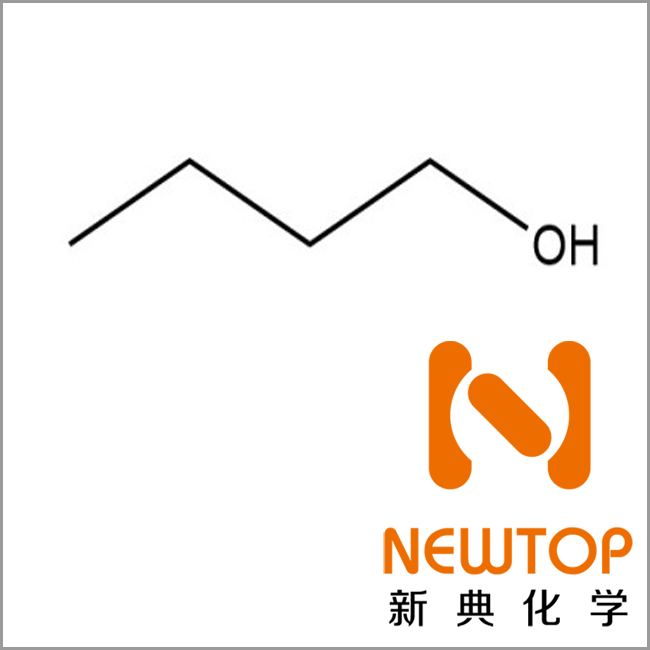n-Butanol CAS71-36-3
n-Butanol CAS71-36-3
Overview:
n-butanol, also known as 1-butanol, is an organic compound with the chemical formula C4H10O, a colorless transparent liquid, slightly soluble in water, soluble in most organic solvents such as ethanol and ether, mainly used in the preparation of esters, plastic plasticizers, pharmaceuticals, spray paint, also used as a solvent.
Chinese name: n-butanol
Alias: 1-butanol
English name: n-butanol; n-butyl alcohol; butanol
Molecular formula(Formula): C4H10O
Molecular Weight(Molecular Weight): 74.122
CAS No.: CAS:71-36-3
Chinese name: n-Butanol, 1-butanol
Molecular structure: See chart
Molecular Formula: C4H10O
Molecular Weight: 74.122
CAS No.: CAS:71-36-3
EINECS No.: 200-751-6
MDL No. MFCD00002964

Physical and chemical properties:
Density: 0.81g/cm3
Melting point: -89℃
Boiling point: 117.6℃
Flash point: 29℃
Refractive index: 1.399 (20℃)
Saturated vapor pressure: 0.73kPa (20℃)
Critical temperature: 289.85℃
Critical pressure: 4.414MPa
Explosive upper limit (V/V): 11.3%
Lower explosion limit (V/V): 1.4%
Appearance: colorless transparent liquid
Solubility: slightly soluble in water, soluble in most organic solvents such as ethanol and ether
Features
Excellent chemical stability. It has the advantages of stable acid value, stable molecular weight, light color and good catalytic effect, and can completely replace potassium naphthenate. Solubility of solute is total solubility. This product is a universal sodium salt-forming agent for synthetic antibiotics by solubilization method. Compared with the traditional salt-forming agent sodium acetate, its obvious advantage is its mildness and stability after salt formation, and it can be soluble in many organic solvents, which is conducive to the separation of anhydrous final products and improves the quality and yield of products.
Uses:
The role and use of n-butanol is a pharmaceutical excipient.
Mainly used in the manufacture of phthalic acid, aliphatic dibasic acid and phosphoric acid n-butyl ester type plasticizers, they are widely used in a variety of plastics and rubber products, but also organic synthesis in the manufacture of butyraldehyde, butyric acid, butylamine and butyl lactate and other raw materials. They are also used as extractants for oils and fats, drugs (such as antibiotics, hormones and vitamins) and spices, additives for alkyd resin coatings, etc. They can also be used as solvents for organic dyes and printing inks, and dewaxing agents.
Used in the production of butyl acetate, dibutyl phthalate and phosphoric acid plasticizers, also used in the production of melamine resin, acrylic acid, epoxy varnish, etc.; used as a chromatographic analysis reagent, also used in organic synthesis, etc.; used in the preparation of bananas, cream, whiskey and cheese and other types of edible flavors.
Toxicity of n-butanol: a low toxicity category
Acute toxicity: LD504360mg/kg (rat oral); 3400mg/kg (rabbit percutaneous); LC5024240mg/m3, 4 hours (rat inhalation)
Sub-acute toxicity: rats, mice inhalation 0.8mg/m3, 24 hours / week, 4 months, abnormal liver and skin function; human inhalation 303 × mg / m × 10 years, mucous membrane irritation, loss of smell; human inhalation 606mg/m3 × 10 years, red blood cell count reduction, occasional eye irritation symptoms; human inhalation 150-780mg/m3 × 10 years, burning sensation in the eyes, general discomfort, the Corneal inflammation.
Storage and transportation:
Should be sealed and stored in a dry, cool and ventilated warehouse
Package:
200KG/drum Storage: It is recommended to store in a dry and cool area with proper ventilation. Please fasten the lid as soon as possible after the original packaging to prevent the mixing of other substances such as water and other substances from affecting the product performance. Do not inhale dust and avoid skin and mucous membrane contact. Smoking, eating and drinking are prohibited in the workplace. After work, shower and change clothes. Store contaminated clothes separately and wash them before use. Maintain good hygiene habits.
Our Company
Since its establishment, the company has adhered to the service tenet of “integrity-based, customer first”, adhered to customer demand as the focus, market-oriented, adhered to technological innovation, management innovation and service innovation, and constantly implemented lean production, refined management, to provide customers with better products and services! The company has its own factory, research and development base, set up a strict scientific quality management system, and constantly committed to technological innovation, product innovation and management innovation, so as to ensure that our products have a certain competitiveness in the same industry. The factory is located in Jining City, Shandong Province, China, covering an area of 500 acres, and the current production capacity of various types of amines is 5,000 to 10,000 tons per year.
Our Advantages
Strict Quality Management
Our company strictly implements ISO9002 quality management standards and has established a complete quality management system to ensure the long-term stability of product quality.
Efficient Service
Our production is efficient and reliable, so we deliver on time and within delivery deadlines. At the same time, our team is always happy to help customers and strive to solve customer problems in a short time.
Competitive Price
We have long-term services in wholesale Polyurethane catalyst and have established long-term and stable cooperative relationships with many retailers and agents to provide our customers with reasonably priced products.
OEM Available
Our employee team has high R&D capabilities, superb design and development capabilities, skilled manufacturing technology, and rich product application experience, and can also meet OEM business needs.throughout the entire industry chain.

